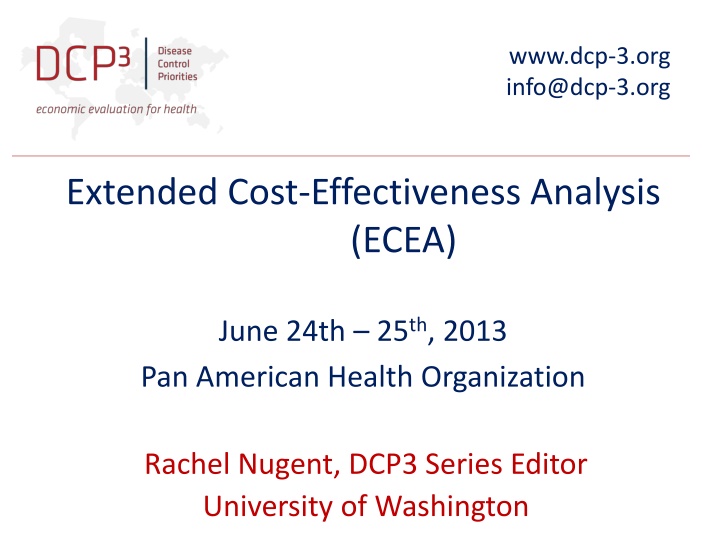
Extended Cost-Effectiveness Analysis (ECEA) in Health Policy Decision-Making
Explore the concept of Extended Cost-Effectiveness Analysis (ECEA) and its application in health policy decisions. Learn about the shift from traditional Cost-Effectiveness Analysis (CEA) to ECEA, focusing on resource allocation, financial risk protection, and distributional consequences. Discover how Universal Public Finance (UPF) impacts health outcomes and financial protection. Case studies like Salt Reduction in South Africa demonstrate the potential of ECEA in tackling public health challenges.
Download Presentation

Please find below an Image/Link to download the presentation.
The content on the website is provided AS IS for your information and personal use only. It may not be sold, licensed, or shared on other websites without obtaining consent from the author. If you encounter any issues during the download, it is possible that the publisher has removed the file from their server.
You are allowed to download the files provided on this website for personal or commercial use, subject to the condition that they are used lawfully. All files are the property of their respective owners.
The content on the website is provided AS IS for your information and personal use only. It may not be sold, licensed, or shared on other websites without obtaining consent from the author.
E N D
Presentation Transcript
www.dcp-3.org info@dcp-3.org Extended Cost-Effectiveness Analysis (ECEA) June 24th 25th, 2013 Pan American Health Organization Rachel Nugent, DCP3 Series Editor University of Washington
Outline Background Limits of CEA Introduction to ECEA Distributional, equity aspects Financial Risk Protection Example 4/28/2025 2
From Cost-Effectiveness Analysis (CEA) to Extended Cost- Effectiveness Analysis (ECEA) Traditional economic evaluation focus (CEA) Cost-effectiveness of technical health interventions (e.g. antiretroviral therapy for HIV/AIDS) Policymaking focus (ECEA) Resources allocated across different options 1) Health interventions 2) Health service delivery platforms 3) Health policy levers (e.g. universal public finance) 3 4/28/2025
Specific Consequences of universal public finance (UPF) Health gains (burden of disease averted) Financial consequences for household expenditures UPF crowds out medical expenses privately financed Financial protection benefits UPF provides insurance to households from medical impoverishment Distributional consequences (across income groups) 4 4/28/2025
Distributional Consequences Traditional CEA often deals in averages for a population. This means not taking into account inequalities in: Access Coverage Cost Incidence Effectiveness Other parameters 4/28/2025 5
Financial Risk Protection FRP can be quantified in many ways Money-metric value of insurance Impoverishments averted Catastrophic Expenditures averted Forced borrowing and asset selling others? Can be useful information for policy-makers to have when defining health packages. 4/28/2025 6
www.dcp-3.org info@dcp-3.org ECEA of Salt Reduction in South Africa Preliminary Example please do not quote 4/28/2025 7
Objective Goal: reduce strokes and other health insults due to high blood pressure Primary target: reduce risk of high blood pressure Immediate lever: reduce salt consumption at population level Policy tool: voluntary reduction of salt in selected manufactured foods 4/28/2025 8
Step 1. Data for the reference population The National Income Dynamics Survey (NIDS) 7300 households, nationally-representative Includes income, consumption, and expenditures Also includes blood pressure, health status, etc All above by age and ethnicity Wave 1 in 2008, wave 2 in 2010, conducted every two years NIDS was used to construct a cohort of 1 million individuals over 40 years of age, separated into income quintiles. No dietary intake data in NIDS. http://www.nids.uct.ac.za/home/
Step 1: Blood pressure by quintile in the NIDS Mean systolic BP was calculated separately for hypertensives (>140mmHg) vs. non-hypertensives (<140mmHg) to capture differential effect sizes from salt reduction
Step 2: Baseline salt intake Dietary surveys from South Africa are heterogeneous Our analysis used urban consumption patterns from a contemporary study in Cape Town Average intake: 7.8g/day in blacks (vast majority of population), 8.5g/day in mixed ancestry folks, 9.5g/day in whites CT salt intake data by ethnicity were combined with NIDS to construct a weighted average salt intake for each quintile
Step 3: Effects of intervention South Africa s proposed policy is complex: involving many food groups, coverage assumptions, and a mass media campaign Target consumption is 5g/day for all ethnic groups Our preliminary intervention is whatever policy is required to reach 5g/day in each quintile The difference between current and target salt consumption levels was used to calculate reductions in blood pressure (He and MacGregor 2004)
Step 4. Estimating CVD cases averted A. Baseline age-specific mortality rates for southern sub-Saharan Africa were obtained from GBD 2010 B. Incident cases of CVD were back- calculated from case-fatality rates for SSA from GBD 2006 C. Age-specific hazard ratios for CVD mortality Analysis was performed separately for stroke and for heart attack (IHD) Fatal stroke and IHD were assumed to be independent events Lewington S et al. Age-specific relevance of usual systolic blood pressure to vascular mortality: a meta-analysis of individual data for 1 million adults in 61 prospective studies. Lancet 2002; 360:1903-13 http://www.healthmetricsandevaluation.org/gbd/visualizations/gbd-2010-patterns-broad-cause-group
Step 5: Types and Costs of treatment Utilization of healthcare was modeled over 1 year (including short-term follow-up and drug costs) Model protocols for managing acute stroke, acute heart attack, and chronic hypertension were designed in consultation with local physicians Assumed daily hospital user fees and average length-of-stay as reported for level 2 hospitals (middle-range estimates) The Uniform Patient Fees Schedule for the Western Cape Province was used to tally professional fees Administration at Groote Schuur Hospital, Cape Town (level 3 facility) provided costs for drugs and devices Assumed 70% of strokes were ischemic and 30% hemorrhagic; no precise data on true proportions, modest effect on treatment costs
A note on the who pays for health care in the South African health system H0 = on any gov t. grant H1 = 0 50,000 ZAR H2 = 50,000 100,000 ZAR H3 > 100,000 ZAR Out of pocket user fees are calculated on a sliding scale basis H0 status is fully subsidized and includes all using government grants (eg, pensioners, veterans, disabled, officially unemployed, etc) About 41% of individuals with H0 status end up paying out of pocket H3 status reflects the full out of pocket cost of care, ie, extent of government subsidies Stroke IHD PUBLIC H0 PUBLIC H1 PUBLIC H2 PUBLIC H3 77 85 188 208 2846 4089 15964 17470 PRIVATE INSURED 6649 9291 PRIVATE UNINSURED 46201 63571 Average out of pocket on acute CVD events (2011 ZAR)
www.dcp-3.org info@dcp-3.org Results
CVD cases averted 150 120 90 CVA IHD 60 30 0 Q1 Q2 Q3 Q4 Q5 8975 cases of CVD in the entire population (12.5 million)
CVD deaths averted 150 120 90 CVA IHD 60 30 0 Q1 Q2 Q3 Q4 Q5 4000 CVD deaths in the entire population (12.5 million)
Average per capita OOP averted 15000 12000 9000 CVA IHD 6000 3000 0 Q1 Q2 Q3 Q4 Q5 R36.7M (about $4M) in total out-of-pocket payments
Cases of catastrophic OOP averted 150 120 90 CVA IHD 60 30 0 Q1 Q2 Q3 Q4 Q5 6600 cases of potentially impoverishing stroke or heart attack
Health benefits, economic benefits tradeoffs? Health & financial risk protection benefits afforded, per $100,000 spent 150 Rotavirus vaccine Pneumococcal conjugate vaccine Measles vaccine Diarrhea treatment Pneumonia treatment Malaria treatment Cesarean section Tuberculosis treatment High blood pressure treatment Number of poverty cases averted 100 Verguet, Olson, Johansson, et al. 2013 50 0 0 100 200 300 400 Number of deaths averted 4/28/2025 21

